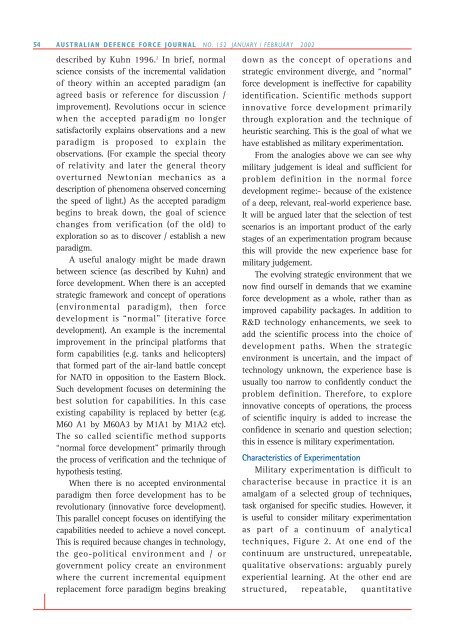ISSUE 152 : Jan/Feb - 2002 - Australian Defence Force Journal
ISSUE 152 : Jan/Feb - 2002 - Australian Defence Force Journal
ISSUE 152 : Jan/Feb - 2002 - Australian Defence Force Journal
- No tags were found...
You also want an ePaper? Increase the reach of your titles
YUMPU automatically turns print PDFs into web optimized ePapers that Google loves.
54AUSTRALIAN DEFENCE FORCE JOURNAL NO. <strong>152</strong> JANUARY / FEBRUARY <strong>2002</strong>described by Kuhn 1996. 2 In brief, normalscience consists of the incremental validationof theory within an accepted paradigm (anagreed basis or reference for discussion /improvement). Revolutions occur in sciencewhen the accepted paradigm no longersatisfactorily explains observations and a newparadigm is proposed to explain theobservations. (For example the special theoryof relativity and later the general theoryoverturned Newtonian mechanics as adescription of phenomena observed concerningthe speed of light.) As the accepted paradigmbegins to break down, the goal of sciencechanges from verification (of the old) toexploration so as to discover / establish a newparadigm.A useful analogy might be made drawnbetween science (as described by Kuhn) andforce development. When there is an acceptedstrategic framework and concept of operations(environmental paradigm), then forcedevelopment is “normal” (iterative forcedevelopment). An example is the incrementalimprovement in the principal platforms thatform capabilities (e.g. tanks and helicopters)that formed part of the air-land battle conceptfor NATO in opposition to the Eastern Block.Such development focuses on determining thebest solution for capabilities. In this caseexisting capability is replaced by better (e.g.M60 A1 by M60A3 by M1A1 by M1A2 etc).The so called scientific method supports“normal force development” primarily throughthe process of verification and the technique ofhypothesis testing.When there is no accepted environmentalparadigm then force development has to berevolutionary (innovative force development).This parallel concept focuses on identifying thecapabilities needed to achieve a novel concept.This is required because changes in technology,the geo-political environment and / orgovernment policy create an environmentwhere the current incremental equipmentreplacement force paradigm begins breakingdown as the concept of operations andstrategic environment diverge, and “normal”force development is ineffective for capabilityidentification. Scientific methods supportinnovative force development primarilythrough exploration and the technique ofheuristic searching. This is the goal of what wehave established as military experimentation.From the analogies above we can see whymilitary judgement is ideal and sufficient forproblem definition in the normal forcedevelopment regime:- because of the existenceof a deep, relevant, real-world experience base.It will be argued later that the selection of testscenarios is an important product of the earlystages of an experimentation program becausethis will provide the new experience base formilitary judgement.The evolving strategic environment that wenow find ourself in demands that we examineforce development as a whole, rather than asimproved capability packages. In addition toR&D technology enhancements, we seek toadd the scientific process into the choice ofdevelopment paths. When the strategicenvironment is uncertain, and the impact oftechnology unknown, the experience base isusually too narrow to confidently conduct theproblem definition. Therefore, to exploreinnovative concepts of operations, the processof scientific inquiry is added to increase theconfidence in scenario and question selection;this in essence is military experimentation.Characteristics of ExperimentationMilitary experimentation is difficult tocharacterise because in practice it is anamalgam of a selected group of techniques,task organised for specific studies. However, itis useful to consider military experimentationas part of a continuum of analyticaltechniques, Figure 2. At one end of thecontinuum are unstructured, unrepeatable,qualitative observations: arguably purelyexperiential learning. At the other end arestructured, repeatable, quantitative
















